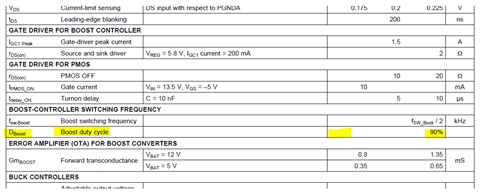What is the minimum possible duty cycle for the boost supply? TPS43330A-Q1

This thread has been locked.
If you have a related question, please click the "Ask a related question" button in the top right corner. The newly created question will be automatically linked to this question.
What is the minimum possible duty cycle for the boost supply? TPS43330A-Q1

Hello, Mr. Moncy,
The boost controller allows the device to operate down to 2 V at the input; the duty cycle of Boost converter D = 1 – (input voltage/output voltage); so, it depends on your output voltage selection (7 V, 8.85 V, or 10 V), the minimum possible duty cycle should be: 71%; 77.4% or 80%. The 90% max duty cycle means the input voltage should be > 1/10 of output voltage.
Thanks!
Phil
Hi Phil,
Thanks for the response. design is for Vout=10V, Switching frequency is 255kHz. I wanted to know the minimum duty cycle that the controller can achieve, means What is the minimum difference needed between my input and output to work the controller as a boost?
Eg: If my input is 9.99V and Vout =10V, the calculated D = 0.1%, which means, that the low side switch On time is around 4.03µs and the high side switch-off time is 4.03nS. Whether this condition can achieve? Does it have a limit of minimum DC? if yes, how much it is? When the controller stops switching and bypasses the input as it is a pre-boost? the input range applicable is 8V to 16V.
I hope you understand the question and waiting for your response.
Regards,
Amal
Hi Amal,
It's much clear now for what you need. I'll find an EVM to implement the tests you're looking for and then update you as soon as I have.
Thanks!
Phil
Hi Amal,
I have the EVM setup for Vout=10V, switching frequency is 200kHz (The closest option on the EVM to 255kHz). I got following test results for you:
Please let me know if you need anything else.
Thanks!
Phil
Hello Phil,
Thank you so much for your testing observation. Can you help me with the following queries?
1.) May I know what this range from 8.53V to 10.25V is? could you be able to see the switching in this range? eg: You could able to see switching at 9.5V, is my understanding correct? what about less than 8.53V?
2. Sorry, I didn't understand the observation, Could you explain?
3. So, my high side switch should be able to switch off time at least 75nS? This implies I should have a MOSFET with a fall time<75nS as my high side drive. Is my understanding correct?

Hi Amal,
Please see my detail description below:
Please let me know if you have further questions.
Thanks!
Phil
Hi Phil,
Thanks again for your detailed explanation. I'm still confused a bit about #1 and #2. In #1 you said <8.53V there is no switching and bypassing the input voltage with some voltage drop. also in #2, the booster stopped switching when VBAT=1.99V. May I know the behaviour in between?
Also, Any idea, why the booster is not boosting the voltage to less than 8.53V? It's supposed to boost the voltage right?
Thanks,
Amal
Hi Amal,
The device is designed for power supplied from car's 12V battery; its booster is designed for the battery voltage lower than its normal level caused by its engine starting moment. Please see specs below for VIN 2V to 40V with condition of "Boost controller enabled, after satisfying initial start-up condition".
![]()
So, VBAT>8.53V is the "start-up condition"; the booster stopped switching when VBAT=1.99V is normal specs.
Please let me know if you have further questions.
Thanks!
Phil